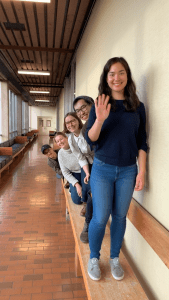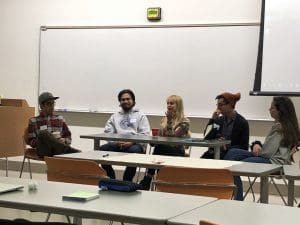Editor’s note: When we changed the 2020 Library Publishing Forum to a virtual conference format, we gave presenters the option of converting their presentations into blog posts. This is a guest post in that series.
By Calvin Chan, Christopher Chan, Shelby Haber, Portia Rayner, Keanna Wallace, and Nadiya Zuk
University of Alberta, Edmonton, Alberta Canada, @URIUofA
The life of an undergraduate journal is often a tumultuous one – each journal has its fair share of ups and downs. Yearly editor turnover, ineffective training, and poor team cohesion can result in the collapse of undergraduate journals. New editors may not feel prepared to handle journal workflow or make editorial decisions. This can make them less likely to be invested in the journal’s long-term success.
Last year, student editors at Spectrum, an undergraduate interdisciplinary journal at the University of Alberta, designed and organized a new editor training model. Unlike past years, which used a more traditional seminar-style training, the model focused on blended learning and team-building activities to train new editors during a weekend-long workshop. Compared to previous years, this training experience resulted in increased team unity, more communication between new and returning editors, and improved understanding of the editorial workflow.
Spectrum – An Undergraduate Interdisciplinary Student Journal
Spectrum is a student journal based out of the University of Alberta’s Undergraduate Research Initiative (URI). The URI program supports undergraduate research across all disciplines. The journal is supported by two faculty advisors and staff from URI, and publishes scholarly work in a variety of formats from all disciplines. While not all research published by Spectrum is necessarily interdisciplinary in scope or topic, all submissions are written and edited with a view to make the work accessible to readers from a variety of disciplines.

Undergraduate journals like Spectrum offer a fantastic training ground for students to learn about the world of scholarly publishing, encourage collaboration between student editors and faculty, and expose students to publishing conventions across disciplines. But, the aspects that make student journals unique can also place them in a precarious position when it comes to editor training and journal longevity. High editor turnover creates challenges for consistency and continuity of journal processes, as well as team cohesion. These challenges underscore the need for robust editorial training that not only provides editors with the knowledge required to be effective, but also integrates team-building and social aspects.
The challenges with Spectrum’s original training model
When Spectrum launched in 2017, editors relied on the PKP School “Becoming an Editor” online course for a basic overview of the editorial process. Over 2018-2019, this evolved into a “learn one, teach one” model. Each editor was assigned to learn one module from the online course, and then teach it to the team. While editors were encouraged to make their modules as interactive as they could (e.g., incorporating group discussions), we found that lectures ultimately weren’t the best tool for facilitating team building. The training was also drawn out over the course of the academic year, with new topics aligning with the journal’s publication schedule. New editors learned about each step of the publishing process as they encountered it in the workflow, which often left editors confused about the overall “big picture” and ill-prepared to handle editorial assignments.
Everything I needed to know was there, but it wasn’t always clear where each step was heading. It’s important to be able to step back and see how all the puzzle pieces fit together. ‑Calvin (returning editor)
Coupled with the lack of focus on team-building activities and the amount of time editors dedicated to training, weekly editorial meetings often felt like “all work, and no play.” This was also a concern for journal continuity, not only in terms of keeping existing editors engaged, but also in facilitating an effective transfer of knowledge to incoming editors.

Reworking the Editorial Training Model
With these challenges in mind, we (the returning and outgoing student editorial board) set out in 2019 to condense and strengthen editorial training, hoping to alleviate the strain on returning editors’ time, improve the skill-building opportunities for new editors, and free up time and resources for other journal projects.
Capturing the Publishing Process Holistically
To help capture the publishing process in its entirety, and give new editors an early appreciation for the overall workflow, we condensed our editor training into a two-day weekend workshop facilitated by senior editors. Incoming editors got the opportunity to work with returning editors to prepare a mock issue from submission to publication, using an OJS sandbox that simulated Spectrum’s actual production site. This way, editors built first-hand experience using OJS, practiced communicating with authors and reviewers (these roles were taken on by returning editors), drafting correspondences, and copy-editing. Some of the activities include:
- Learning how to navigate the OJS system from author, reviewer, and editor perspectives
- Working in small groups to perform mock peer-review led by a returning editor
- Working through a copy-editing exercise with a returning editor
- Practicing drafting emails (e.g. manuscript rejection, request for revisions) to authors

At the end of the two-day workshop, new editors were able to complete a process map listing all of the major steps in the publishing process and what was involved. Using this condensed model, new and returning editors started the academic year with an improved understanding of the journal in its entirety.
Going through the process of a mock submission helped me see how each step of the publishing process is related to the others. It gave me a better understanding of the journal as a whole and helped me remember the focus of each individual step. ‑Shelby (incoming editor)

Training as Experience to Build Team Culture
To address the challenge of team cohesion given high editor turnover, we also integrated team-building and collaboration into the entire training experience. Incoming editors were encouraged to collaborate with returning editors on specific tasks, enabling the team to build camaraderie, and to help incoming editors feel comfortable asking questions.
In between these exercises we also inserted games and other activities. These served as both a break from training and as a tool to encourage communication between editors. Some activities include:
- Team-based jeopardy game that encouraged editors to lean on each other’s knowledge and expertise, and test their understanding of publishing concepts.
- A modified Cranium game that included publishing-themed questions and light-hearted team challenges to build team cohesion.
- Ice-breaker activities to give student editors a chance to learn about each other’s interests and hobbies.
I found that the team-building activities were a great way to get to know everyone in a more informal way. It created a fun atmosphere with room for silly questions — when we reconvened for our first official meeting in September, we already had a couple of running jokes from training. ‑Nadiya (incoming editor)

Both new and returning editors found that the face-to-face interaction at the training workshop helped set the stage early for cooperation and teamwork. Editors felt more comfortable reaching out to each other for help and advice both online and in-person over the summer and in the academic year.
Being able to work with actual submissions over the summer boosted my confidence during the academic year. By the time that September came around, I had already experienced corresponding between editors and reviewers, and I was used to asking my fellow editors if I wasn’t sure what to do next. ‑Shelby (incoming editor)
See an outline of our two-day training workshop here.
Opening the Door to Other Projects in the Academic Year
By addressing some of the weaknesses we observed in previous years, this training model helped open up time and resources for the team to tackle other projects. These included:
- Peer Reviewer Workshop – Spectrum editors collaborated with the University of Alberta Libraries to develop a hands-on workshop for undergraduate and graduate students interested in learning how to perform effective and consistent peer reviews. The workshop was facilitated by library staff, with student editors assisting with a mock review exercise.
- Themed Issue – Editors organized a call for submissions to a Sustainability-themed issue of Spectrum that will be published during the 2020/2021 academic year.
- Journal Promotion/Outreach Activities – Editors participated in two showcase events (one hosted by U of A Libraries during Open Access Week, and one hosted by the Students’ Union promoting undergraduate research opportunities). The team also had a takeover of the Dean of Students’ Instagram account to promote the journal to prospective authors and peer-reviewers.
- Team excursions and celebrations – With less time dedicated to training during the academic year, the team had the opportunity to organize celebratory events (e.g. Christmas party) and participate in educational excursions (e.g. touring an open-access collaboration centre for nanoscale engineering, and attending a showcase of a Voynich manuscript replica – an undeciphered 15th century codex).
These activities not only made the editorial experience more well-rounded and fun, but they also helped raise awareness of Spectrum across campus, and fostered connections with other student journals.
Challenges of the Two-Day Training Model
Despite the success that came with the two-day training model, the Spectrum team faced a few major challenges while planning and implementing the training weekend.
- The two-day training requires significant initial planning – For a workshop in late April, editors started planning in early February. While this is a much longer time than it takes to plan lectures throughout the academic year, this first-time planning created a road-map that should make organizing easier in the future.
- It is difficult to develop hands-on practice for the production stage – Layout and production are particularly time-consuming and technically challenging aspects. During the workshop, the editorial team chose to describe the production process only and reserved the hands-on practice for a later time in the academic year when the skills became more relevant.
- Training at the end of the academic year – The condensed nature of the two-day workshop means that a lot of information is learned within a narrow time frame. There’s also a gap between when editors learned and applied some of the training (e.g. copyediting). While hosting the workshop at the end of April enabled new editors to practice the first steps of the publication process over the summer, it was also difficult to schedule the session around final exams. The larger the editorial board, the more difficult it will be to set a day and time that works for everyone.
- Transitioning to a virtual environment – An unexpected issue arose when we had to cancel this year’s in-person workshop due to COVID-19. For this year, we have postponed editor recruitment and training until the beginning of the 2020/2021 academic year, and are working on plans to transition the training into a virtual environment. This will give us the opportunity to see how the training weekend works when new editors don’t have the summer to slowly work through new submissions before the academic year begins.
Overall, editors at Spectrum found that investing the time and energy into planning a condensed editor training workshop yielded great benefits for both journal productivity, but also overall enjoyment for volunteer editors. New editors are more confident in their understanding of journal workflow, and require less time for ongoing training during the publication schedule. Moving away from lecture-style modules and towards team-based blended learning activities not only made training much more engaging and exciting, but also improved editor confidence and fostered friendship and camaraderie between editors! The whole team was also able to explore and strengthen other aspects of journal business: outreach, community engagement, and content development.
Acknowledgements
Special thanks to the past student editors who were involved in planning and implementing the training model: Abhi Aggarwal, Natalie Eng and Susannah Mackenzie-Freeman. We also thank Spectrum’s faculty advisors, Dr. Lisa Claypool and Dr. Joao Soares, URI Team Lead, Crystal Snyder, and University of Alberta Library Publishing Program staff for their ongoing support of Spectrum’s work.
